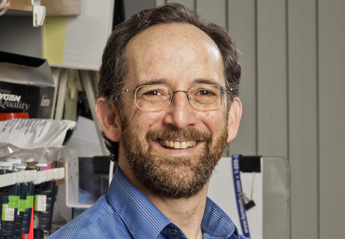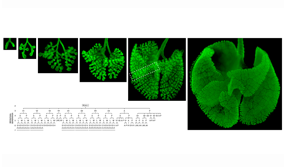
Scientific Discipline
Developmental Biology, Genetics
Related Links
Host Institution
Stanford University
Current Position
Dr. Krasnow is also a professor in the Department of Biochemistry at Stanford University School of Medicine.
Current Research
Building, Regenerating, and Controlling the Lung
Research
Biography
In his office, Mark Krasnow unfurls a remarkable scroll. It's a 29-page printout, the pages carefully taped together. On it lies a flowchart, but not for a computer program. The hierarchy of lines and notations represents a mouse lung, all 5,051 airways of it. For the first time, thanks to Krasnow and his colleague Ross Metzger, scientists now know precisely how the mouse lung develops—all the sprouting and branching that expands a simple embryonic tube into a mass of filament-fine airways that pour oxygen deep into the animal's body.
"The lineage diagram is one of my favorite things that we've accomplished," says Krasnow. "All of the branches have been named, and we know how they relate to each other."
The outsized diagram settled a dispute among scientists studying lung development. Some had thought that the sheer number of terminal tubes in the lung meant its growth must be random. Instead, Krasnow and Metzger discovered that the pattern of development is highly stereotyped—almost identical from individual to individual—and composed of just three local patterns of branching combined in three different sequences throughout the lung.
"We're hoping this discovery will transform our understanding of lung development," says Krasnow, "and also provide new tools to researchers studying lung diseases." Premature infants, in particular, he adds, could benefit from knowledge of how to speed up lung growth.
But just knowing the physical pattern of lung development isn't enough for Krasnow. He wants to map all the genes and molecules involved, to understand at the molecular level the biological program that creates such a complex organ.
Like many organs—kidneys, pancreas, blood vessels—the lung is a series of tubes. "The tube is a fundamental unit of organ design," says Krasnow. "And early in my career I realized there were many fascinating developmental questions about them. How do you make a branched tubular structure? How do you know where each of the branches forms? How do they know where to grow out? How do they know where to sprout again? How do you control those elaborate patterns of branching and the size of each individual branch?"
To begin to answer these questions, and long before moving to the mouse, Krasnow picked the biologist's model organism of choice, the fruit fly. Developmental biologists had been studying the fly's external features and nervous system but were ignoring the internal organs. Krasnow decided to fill this gap by focusing on the fly's tracheal system—a primitive lung. He set about systematically answering his list of questions, one at a time.
Entomologists, particularly Sir Vincent Wigglesworth, had made careful observations of insect tracheal systems' development and function. Krasnow started with these observations and went on to identify the genetic factors that control the organ's development. Early in his career, he had worked on the most famous developmental control gene, called Ultrabithorax, which directs the development of the thorax in insects, and later discovered how other genes direct the growth of the tracheal system.
Now, years later, and with the help of many students, postdocs, and other labs, the genetic control program that creates the tracheal system in the fly has been mapped. "It is now one of the best, if not the best, understood organogenesis programs of any organ in any animal," says Krasnow.
Despite his mouse-lung scroll, though, Krasnow thinks this is just the beginning of understanding mammalian lung development. He's just now starting to map how all the supporting structures—the blood vessels, smooth muscle, and nerves, for instance—develop in parallel with the airways. "There's not just a single network, like in fruit flies," says Krasnow. "There are several coordinated networks, and the cellular biology and genetics of it are much more complex."
Eventually, Krasnow hopes this knowledge will lead to better understanding of and treatments for lung diseases, because the genes that build and maintain healthy lungs often go awry in cancer, asthma, and other lung diseases.
"There are many things we can learn that will help patients," says Krasnow. "And along the way there are many fascinating scientific questions and challenges that keep us going."
Articles & News
Research Papers
Selected Research Papers




